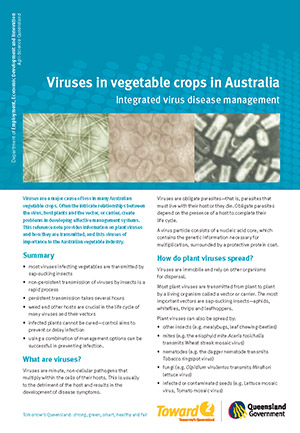|
|
Viruses are a major cause of loss in many Australian vegetable crops. Often the intricate relationships between the virus, host plants and the vector, create problems in developing effective management systems. Viruses are minute, non-cellular pathogens that multiply within the cells of their hosts. This is usually to the detriment of the host and results in the development of disease symptoms. This 6 page factsheet provides information on plant viruses and how they are transmitted, and lists viruses of importance to the Australian vegetable industry. Authors : Topics covered :
Key Points : Most viruses infecting vegetables are transmitted by sap-sucking insects
See Also : Acknowledgements : This technical reference note has been produced by Denis Persley and Cherie Gambley (DEEDI) as part of the Horticulture Australia Limited project VG-07128-Integrated management of viral diseases in vegetables. This project has been facilitated by State Governments, and Horticulture Australia Limited (HAL) in partnership with AUSVEG through the National Vegetable Research and Development Levy. The Australian Government provides matched funding for all HAL’s R&D activities. |
|

